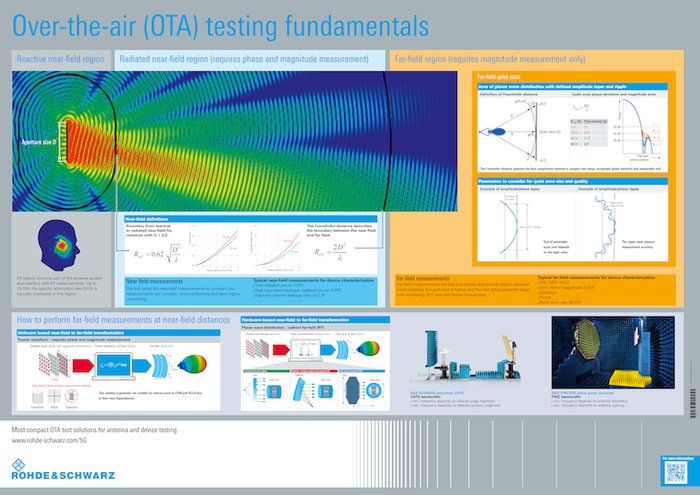Free Chart Clarifies Over-the-Air Testing
Rohde & Schwarz free wall chart aids understanding of Over-the-Air antenna and device hardware testing.
March 31, 2021

Over-the-Air (OTA) testing has become a cornerstone in the development and deployment of IoT devices and products. While many designers focus their testing energies and budgets on software, the hardware aspects of OTA devices can be neglected. It is important to make sure the antennas designed or selected will perform as intended.
The device and its environment must be considered during the development phase. For example, the design of an antenna for a large stationary device like a vending machine needs to include the operational environment, namely, that the machines will likely be installed or placed against a wall. Designing or selecting an antenna that concentrates its energy and radiates toward the front of the device would be ideal for this environment.
Conversely, the antenna design and subsequent test of a smartphone must allow for the antenna to radiate in all directions and not lose communication when the user moves around or faces a particular direction away from the cell tower.
Over-the-Air antenna testing and measurement are the only way to empirically qualify the entire signal path and antenna pattern of a stationary or mobile wireless device.
Cellular and Wireless Testing
Most wireless devices, especially in the smart mobile device market, utilize an error correction algorithm to compensate for a poor receive signal either by increasing the output transmit power or reducing the data rate before the connection is lost. This is the basic approach used by all major technologies, including cellular GSM, GPRS, CDMA, WCDMA, LTE, and wireless technologies such as 802.11 a/b/g/n/ac, Bluetooth, and ZigBee, and many others.
As most engineers know, there is always a tradeoff. For example, increasing the output power can cause a reduction in battery life, which heats up the device and will probably lower the data transfer rate. Here is where OTA testing of antennas can help development teams identify the problematic areas to hopefully improve the product user experience by increasing product performance and reliability.
The growth of 5G New Radio (NW) technologies – the global standard for the air interface of 5G networks - only adds to the challenges for OTA hardware development. The higher device integration and much higher frequencies required by 5G are driving the demand to test devices OTA. How do device dimensions and the chosen frequency range drive size and space requirements in OTA test setups?
Several companies are involved in testing the most critical OTA parameters and also providing a concise overview of how to perform far-field measurements at near-field distances. For example, Rohde & Schwarz has created a free poster to explore OTA testing and discover the most compact OTA test solutions for antenna and device testing. There is also a white paper that provides further technical details.
Another good resource comes from Siemens-EDA in the form of a paper that presents an introduction to antennas in general, their parameters and different types, as well as antenna characterization and testing.
Hardware testing for OTA devices is challenging, but these resources and others will help you ensure your products work as designed and intended.

John Blyler is a Design News senior editor, covering the electronics and advanced manufacturing spaces. With a BS in Engineering Physics and an MS in Electrical Engineering, he has years of hardware-software-network systems experience as an editor and engineer within the advanced manufacturing, IoT and semiconductor industries. John has co-authored books related to system engineering and electronics for IEEE, Wiley, and Elsevier.
About the Author(s)
You May Also Like





